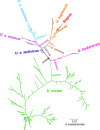Retreat and extinction of the Late Pleistocene cave bear (Ursus spelaeus sensu lato)
- PMID: 27730265
- PMCID: PMC5059403
- DOI: 10.1007/s00114-016-1414-8
Retreat and extinction of the Late Pleistocene cave bear (Ursus spelaeus sensu lato)
Abstract
The cave bear (Ursus spelaeus sensu lato) is a typical representative of Pleistocene megafauna which became extinct at the end of the Last Glacial. Detailed knowledge of cave bear extinction could explain this spectacular ecological transformation. The paper provides a report on the youngest remains of the cave bear dated to 20,930 ± 140 14C years before present (BP). Ancient DNA analyses proved its affiliation to the Ursus ingressus haplotype. Using this record and 205 other dates, we determined, following eight approaches, the extinction time of this mammal at 26,100-24,300 cal. years BP. The time is only slightly earlier, i.e. 27,000-26,100 cal. years BP, when young dates without associated collagen data are excluded. The demise of cave bear falls within the coldest phase of the last glacial period, Greenland Stadial 3. This finding and the significant decrease in the cave bear records with cooling indicate that the drastic climatic changes were responsible for its extinction. Climate deterioration lowered vegetation productivity, on which the cave bear strongly depended as a strict herbivore. The distribution of the last cave bear records in Europe suggests that this animal was vanishing by fragmentation into subpopulations occupying small habitats. One of them was the Kraków-Częstochowa Upland in Poland, where we discovered the latest record of the cave bear and also two other, younger than 25,000 14C years BP. The relatively long survival of this bear in karst regions may result from suitable microclimate and continuous access to water provided by deep aquifers, indicating a refugial role of such regions in the Pleistocene for many species.
Keywords: Ancient DNA; Cave bear; Extinction; Last glacial maximum; Megafauna; Refugium.
Figures







Similar articles
-
Large-scale mitogenomic analysis of the phylogeography of the Late Pleistocene cave bear.Sci Rep. 2019 Aug 15;9(1):10700. doi: 10.1038/s41598-019-47073-z. Sci Rep. 2019. PMID: 31417104 Free PMC article.
-
Withering away--25,000 years of genetic decline preceded cave bear extinction.Mol Biol Evol. 2010 May;27(5):975-8. doi: 10.1093/molbev/msq083. Epub 2010 Mar 24. Mol Biol Evol. 2010. PMID: 20335279
-
Ursus spelaeus (Rosenmüller, 1794) during the MIS 3: new evidence from the Cioclovina Uscată Cave and radiocarbon age overview for the Carpathians.Isotopes Environ Health Stud. 2025 Mar;61(1):101-113. doi: 10.1080/10256016.2024.2376730. Epub 2024 Jul 24. Isotopes Environ Health Stud. 2025. PMID: 39049521
-
Ecological change, range fluctuations and population dynamics during the Pleistocene.Curr Biol. 2009 Jul 28;19(14):R584-94. doi: 10.1016/j.cub.2009.06.030. Curr Biol. 2009. PMID: 19640497 Review.
-
A review and synthesis of late Pleistocene extinction modeling: progress delayed by mismatches between ecological realism, interpretation, and methodological transparency.Q Rev Biol. 2014 Jun;89(2):91-106. doi: 10.1086/676045. Q Rev Biol. 2014. PMID: 24984323 Review.
Cited by
-
Large-scale mitogenomic analysis of the phylogeography of the Late Pleistocene cave bear.Sci Rep. 2019 Aug 15;9(1):10700. doi: 10.1038/s41598-019-47073-z. Sci Rep. 2019. PMID: 31417104 Free PMC article.
-
Partial genomic survival of cave bears in living brown bears.Nat Ecol Evol. 2018 Oct;2(10):1563-1570. doi: 10.1038/s41559-018-0654-8. Epub 2018 Aug 27. Nat Ecol Evol. 2018. PMID: 30150744 Free PMC article.
-
The effect of body size evolution and ecology on encephalization in cave bears and extant relatives.BMC Evol Biol. 2017 Jun 5;17(1):124. doi: 10.1186/s12862-017-0976-1. BMC Evol Biol. 2017. PMID: 28583080 Free PMC article.
-
Heavy reliance on plants for Romanian cave bears evidenced by amino acid nitrogen isotope analysis.Sci Rep. 2020 Apr 20;10(1):6612. doi: 10.1038/s41598-020-62990-0. Sci Rep. 2020. PMID: 32313007 Free PMC article.
-
Biomechanical simulations reveal a trade-off between adaptation to glacial climate and dietary niche versatility in European cave bears.Sci Adv. 2020 Apr 1;6(14):eaay9462. doi: 10.1126/sciadv.aay9462. eCollection 2020 Apr. Sci Adv. 2020. PMID: 32270039 Free PMC article.
References
-
- Adams B. New radiocarbon dates from Szeleta andIstállóskő Caves, Hungary. Praehistoria. 2002;3:53–55.
-
- Alscher M (2013) Morphologie und Metrik der Phalangen in der Höhlenbärengruppe. Universität Wien
-
- Athen K. Biostatistical investigation of long bones and metapodial bones of Ursus spelaeus and Ursus deningeri. Sci Ann Sch Geol Aristot Univ Tessaloniki (AUTH) 2006;98:159–162.
-
- Baca M, Stankovic A, Stefaniak K, Marciszak A, Nadachowski A, Węgleński P, Mackiewicz P. Genetic analysis of cave bear specimens from Niedźwiedzia cave. Palaeontol Electron. 2012;15:16.
-
- Baca M, et al. Ancient DNA and dating of cave bear remains from Niedźwiedzia Cave suggest early appearance of Ursus ingressus in Sudetes. Quat Int. 2014;339-340:217–223. doi: 10.1016/j.quaint.2013.08.033. - DOI
MeSH terms
LinkOut - more resources
Full Text Sources
Other Literature Sources

